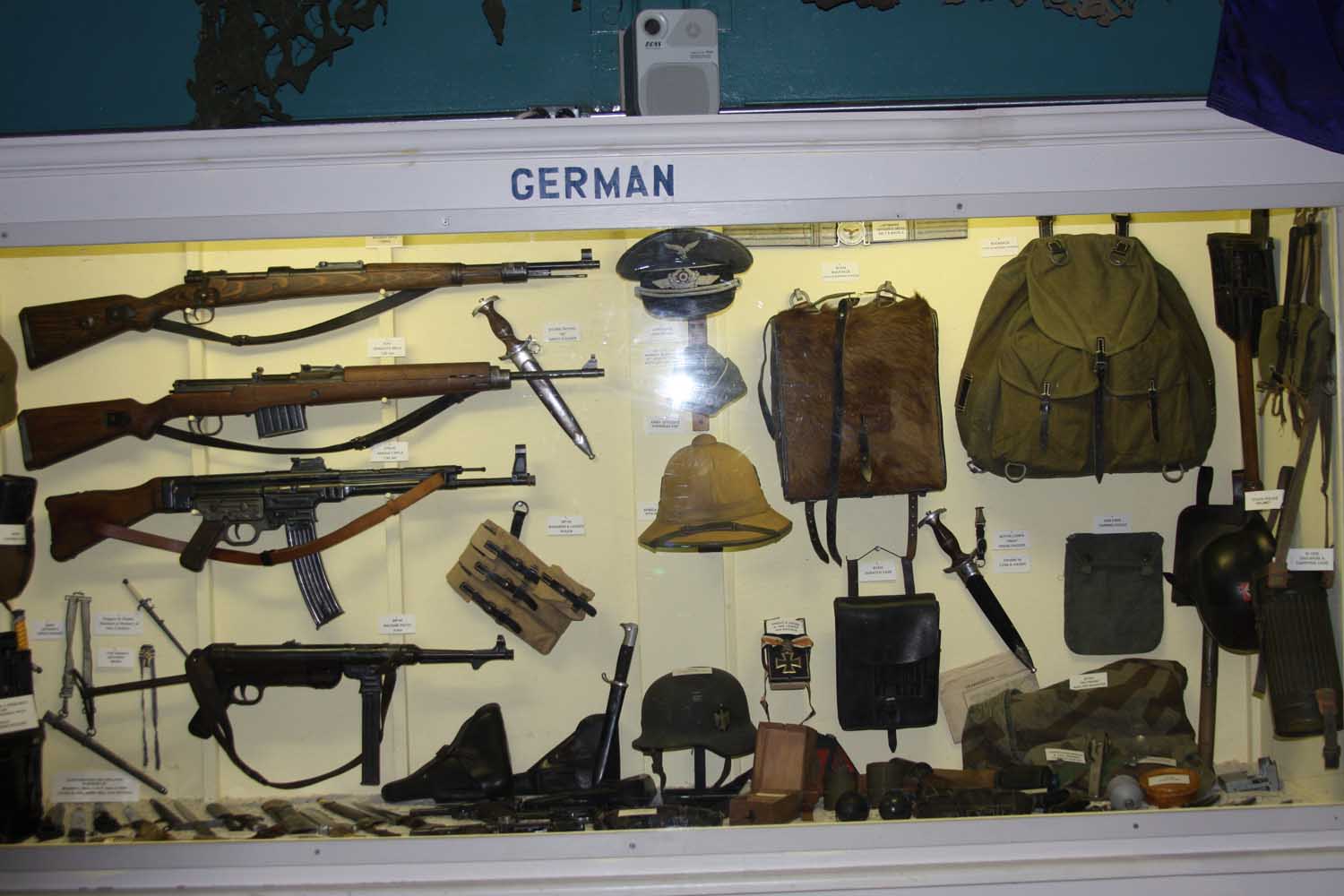MP40 machinepistol:
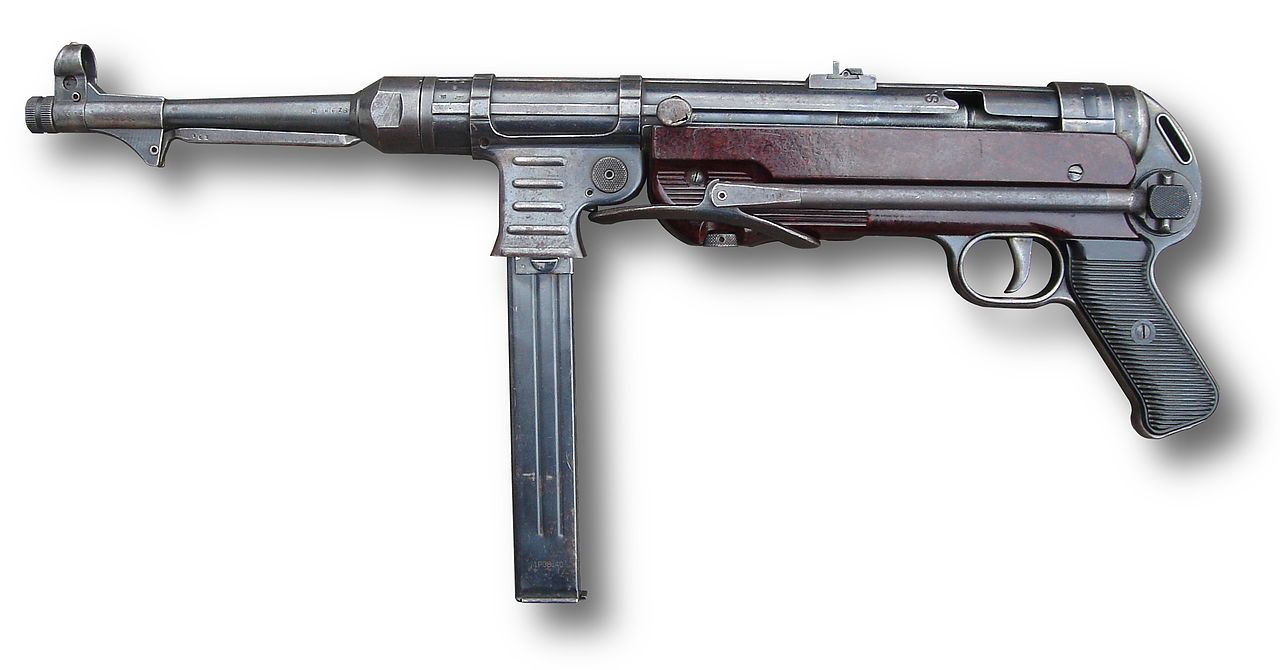
The MP 40 Maschinenpistole 40 is a submachine gun produced by the German military chambered for the 9×19mm Parabellum cartridge. It was designed by by Heinrich Vollmer in 1938 and inspired by the MP38 machinepistol. The MP40 was imensely popular and was heavily used by infantrymen and paratroops on the Western and Eastern fronts. Over 1 million were produced. This weapon is sometimes erroneously refered to as the "Schmeisser" which is actually a common name for the MP18. The MP40 was the result of re-design of two previous weapons: the MP36 and the MP38. Much of the improvement was intended to resolve ease of manufacturing issues such as use of stamped metal assemblies instead of milled parts. The MP 40 submachine guns fire from open-bolt, and are blowback-operated automatic arms. The MP40 only fires in fully automatic mode but its relativley slow cyclic rate allowed single shots to be fired. The MP40 has an aluminum, steel, or bakelite resting bar or support under the barrel used to steady the weapon when firing over the side of open-top armored personnel carriers. The MP40 also had a Bakelite handguard located between the magazine housing and the pistol grip. The barrell lacks a heat-insulating grip which led to burns on the supporting hand of the operator if held incorrectly. The MP40 was also the first machine pistol to be equiped with an underfildong stock. The underfolding stock made the weapon much more compact however, in use, the locking mechanism would wear out permaturely after subjected to heavy use and render the weapon unstable. Although generally considered reliable, the design of the magazine did result in shortcomings: when used incorrectly as a grip, the magazine could warp slightly causing misfeeds when firing. The magazine used a single-feed insert which increased friction against cartridges moving upwards towards the feed lips, which, especially when contaminated iwth debris, could cause misfeeds.
M98k rifle (Byf 44), 7.92mm:
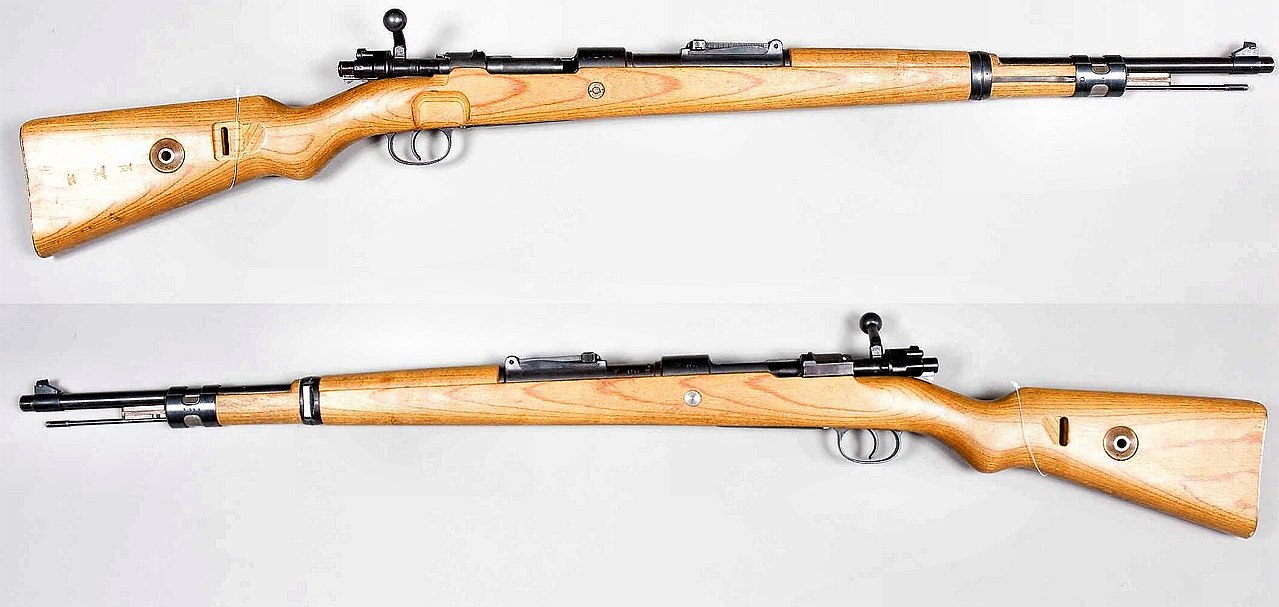
The M98K rifle, formally known as the Karabiner 98 kurz is a bolt-action rifle chambered for the 7.92×57mm Mauser cartridge. The rifle was adopted in 1935 as the standard service rifle for the German Wehrmacht and remained in use by the German military until the end of the war in 1945. Developement of the 98K began in 1934 and was based on the design of the Mauser Standardmodell rifle of 1924. The 98K rifle is noted for its reliability, accuracy and effective range, up to 500 meters with iron sights and 1000 meters with telescopic sights. The Karabiner 98k is a controlled-feed bolt-action rifle based on the Mauser M98 system. The rifle has an internal 5 round magazine which can be loaded by hand one round at a time, or by use of brass stripper clips. The Karabiner 98k has a rear tangent sight, and a front sight fitted with a hood to reduce glare and to protect the front sight post. Early Karabiner 98k rifles had solid walnut wood or oak one piece stocks, but later versions were equiped with laminated stocks. Laminated stocks were stronger than one piece solid wood stocks but were also heavier. Stocks were equiped with a metal buttplate. The design of the 98K originated at a time when standard military doctrine dictated that battle rifles were to be used by skilled marksmen firing at targets at relativley long ranges. Also, the bolt action rifle was intended to supplement the firepower provided by general purpose and light machine guns. However, this philosphy tended to unravel as other military organizations produced submachine guns such as the PPSH which were much more effectvive at close range experienced in urban environments. Towards the end of WW2, the German Military began producing its own fully automatic battle rifles to replace the bolt action 98K introducing the STG44 rifle. Developement of the 98K began in 1934 and was based on the design of the the Mauser Standardmodell rifle of 1924. The 98K rifle is noted for its reliability, accuracy and effective range, up to 500 meters with iron sights and 1000 meters with telescopic sights. The Karabiner 98k is a controlled-feed bolt-action rifle based on the Mauser M98 system. The rifle has an internal 5 round magazine which can be loaded by hand one round at a time, or by use of brass stripper clips. The Karabiner 98k has a rear tangent sight, and a front sight fitted with a hood to reduce glare and to protect the front sight post. Early Karabiner 98k rifles had solid walnut wood or oak one piece stocks, but later versions were equiped with laminated stocks. Laminated stocks were stronger than one piece solid wood stocks but were also heavier. Stocks were equiped with a metal buttplate. The design of the 98K originated at a time when standard military doctrine dictated that battle rifles were to be used by skilled marksmen firing at targets at relativley long ranges. Also, the bolt action rifle was intended to supplement the firepower provided by general purpose and light machine guns. However, this philosphy tended to unravel as other military organizations produced submachine guns such as the PPSH which were much more effectvive at close range experienced in urban environments. Towards the end of WW2, the German Military began producing its own fully automatic battle rifles to replace the bolt action 98K introducing the STG44 rifle.
STG-44 Assault rifle, 7.92mm (#6491)

The STG44 is a famous contribution to weapons design philosphy and the advent of the assault rifle concept. It was a weapon designed to address new realities of the modern battlefield and a departure from tradition. These are the primary considerations addressed by the design of the STG44: It was observed that most combat took place at ranges well within the effective range of the large battle rifle calibers. The STG44 was designed to provide firepower at a more moderate range than tipical battle rifles of the time period. The 98K rifle was expected to have an effective range of up to 800 meters whereas the smaller cartridge of the STG44 was 400 meters. This placed more firepower in the hands of assaulting infantry, something more relevant when facing formations of Soviet troops equiped with the PPSH. The STG 44 was also smaller and more compact than typical battle rifles. The STG44 used a smaller cartridge which allowed it to fire with greater effectiveness in full automatic mode. The smaller cartridge was more powerfull than the pistol rounds fired by the machinepistol.
MG 42 Light Machine Gun:
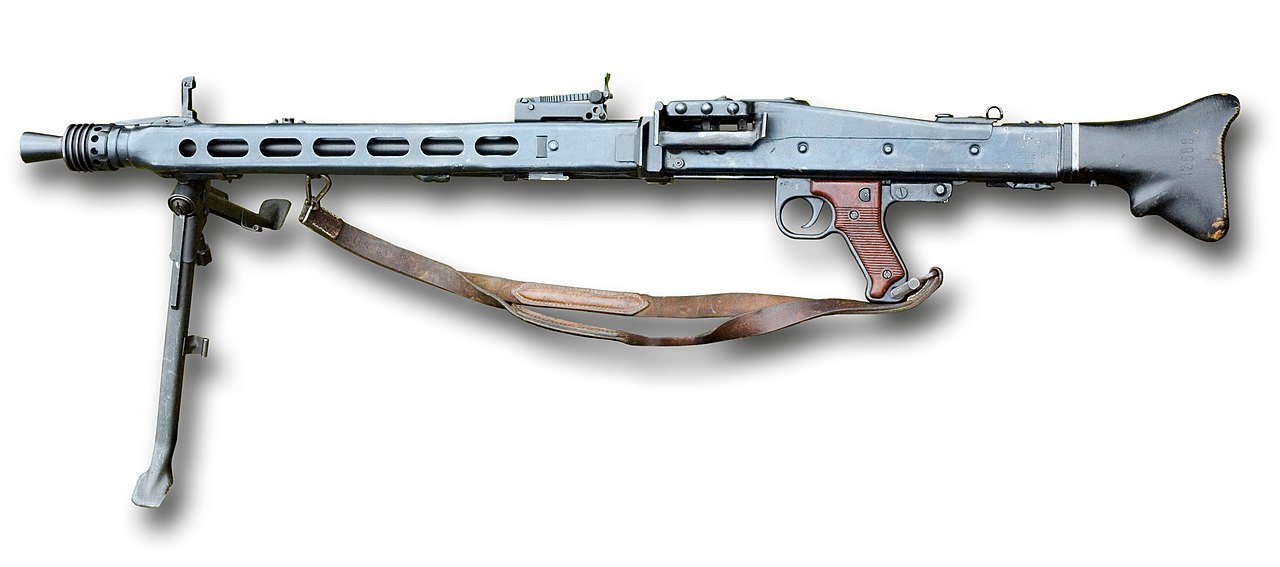
The MG 42 or Maschinengewehr 42, is a general-purpose machine gun designed by the German military and heavily used by the Wehrmacht and the Waffen-SS during the second half of World War II. It is chambered for the 7.92×57mm cartridge. It was intended to replace the MG34 which was more expensive and difficult to manufacture. The MG42 is one of the most successful machine gun designs in history. It is very reliable, has a high cyclic rate, and proved exteremely effective in service on the battlefield. They were known to produce a characteristic "buzz saw" sound when firing. A 50 round belt could be expended during sustained fire after 2 and 1/2 seconds. In decades following WW2, many succesful machine gun designs over the world were based on the MG42. The gun was crewed by two to three troops and weighed 24 pounds. The MG42 was air cooled and recoil operated. During operation, the barrel had to be changed every 250 rounds. The gun was fed by 50 round belts or 75 round drums. More than 400,000 were produced during WW2. Interestingly, the German military philosphy employed machineguns as primary weapons with troops armed with rifles intended as support. The reverse was true for Allied Forces, which used machinegun squads to support rifle infantry. The MG 42 was usually sited in concealed ground and manned by two gunners under the direction of a section leader. Reverse slopes were the preferred covered positions.
G-41 Semi Automatic Rifle:
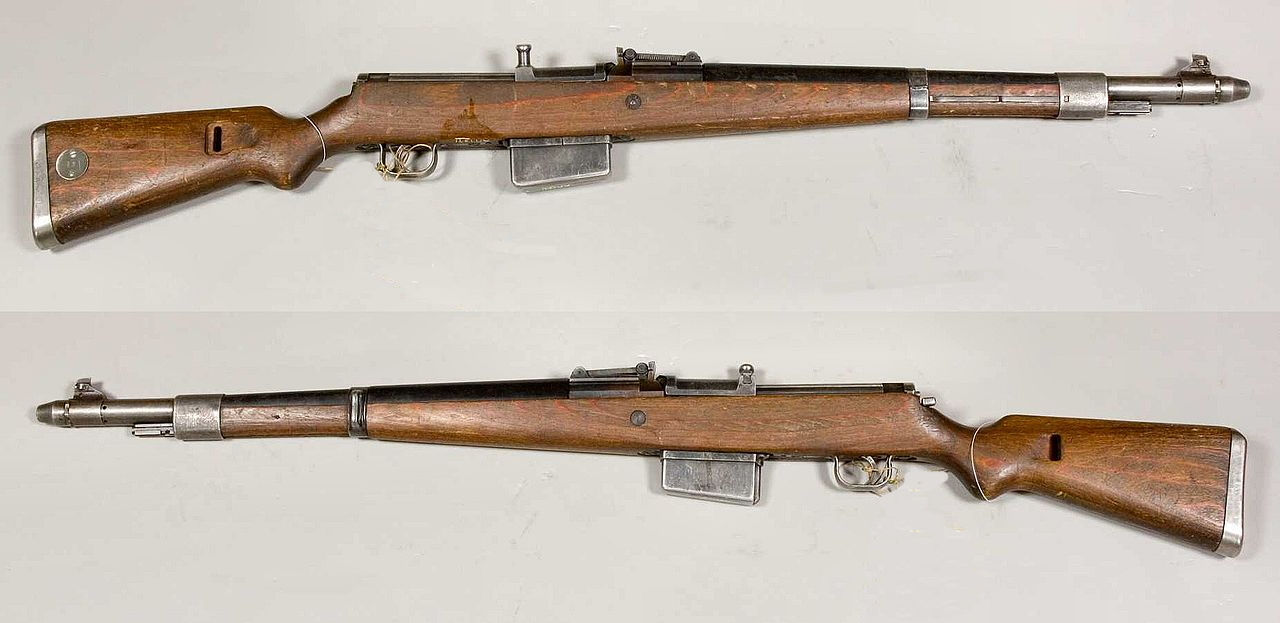
The G41 semi-automatic rifle was the German military's response to the demand for higher rates of fire as the standard battle rifle, the 98K bolt action rifle. Design criterion dictated by the military required that the rifle have a manual mode, could be fired in bolt action, or operate in semi-automatice mode. The rifle also had to be made without gas system ports in the barrel. The G41 employed a gas system where propellant gases were captured by a cone-shaped gas trap at the muzzle, which in turn deflected them to operate a small piston which in turn pushed on a long piston rod that opened the breech and re-loaded the gun. This is completely different from the more conventional systems where a port was located in the barrel where gases could be tapped such as the system employed in the Kalashnikov rifles. The G41 also utilized a fixed 10 round magazine which was replentished with rounds from the stripper clips used for the 98K rifle. This made reloading a slower process than with detachable magazines. These heavy rifles were over complicated in design, and unreliable. The front sight was located on the gas tube at the front of the rifle, and was subject to some movement when the rifle was fired. This resulted in a loss of accuracy. Also, the gases required to operate the action which had to come from the muzzle could cool and produce more fouling which contributed to the rifle's unreliablity. Accurate figures are unknown, but it is estimated that between 40,000 and 140,000 of these were produced.
G-43 Semi Automatic Rifle:
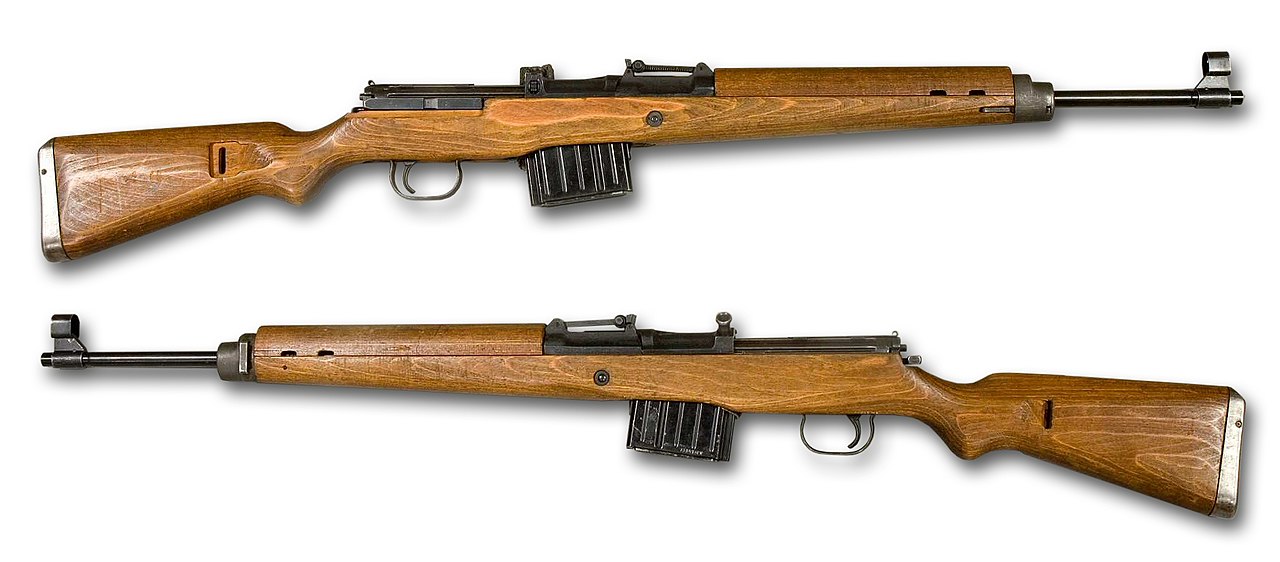
Problems with the G41 and examinations of the Soviet SVT-40 led to the design evoltuion which resulted in the G43 rifle. During Babarossa, the German military found itsself outcalssed by the Soviet army's new semi-automatic rifles, namely the SVT38 and SVT40. The G43 was Germany's answer. The G43 employed a gas system design similar to the SVT40 where the barrel was tapped about 1/3 from the end of the barrel instead of the tap located on the muzzle of the G41. This one design change offered immediate improvement. The G43 design also implemented a detachable 10 round magazine which greatly improved fast reloading operation. The G43 was put into production in 1943. Gewehr 43s were made by Berlin-Lübecker Maschinenfabrik in Lübeck . Walther used its satellite production facilities at Neuengamme concentration camp in addition to its main production facilities at Zella-Mehlis to make the rifles, Wilhelm Gustloff-Werke used some slave workers from Buchenwald concentration camp. Total production is estimated to be over 400,000.
G 33/40 Mountain Carbine:
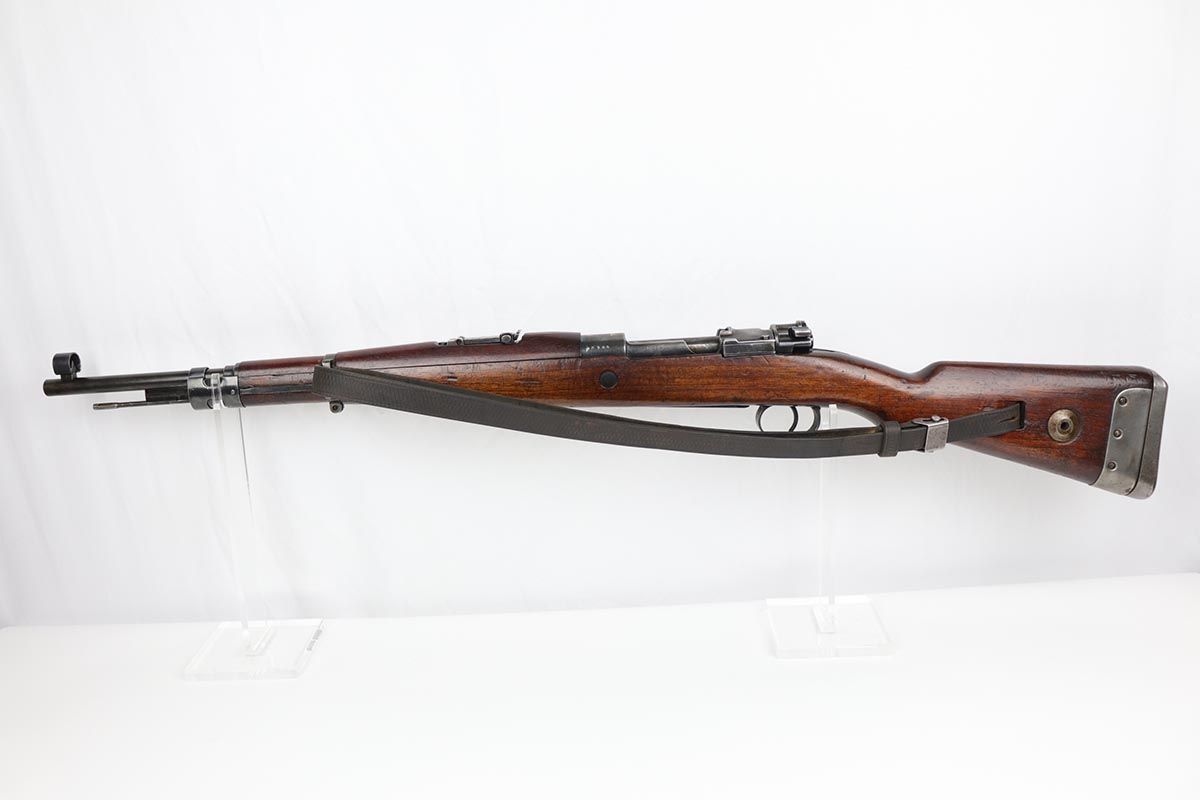
The G33 is a varient of the Mauser 98K carbine rifle. The G33 or Gewehr rifles were produced in Czechoslavakia which was under German occupation. This rifle was intended to be supplied to mountain troops. These rifles were produced in small numbers between 1940 and 1942 with an estimated 120,000 made. Similar to the 98K, the G33/40 employed an internal 5 round magazine. Sights were adjustable to 1,000 meters.
P-08 Luger Pistol:
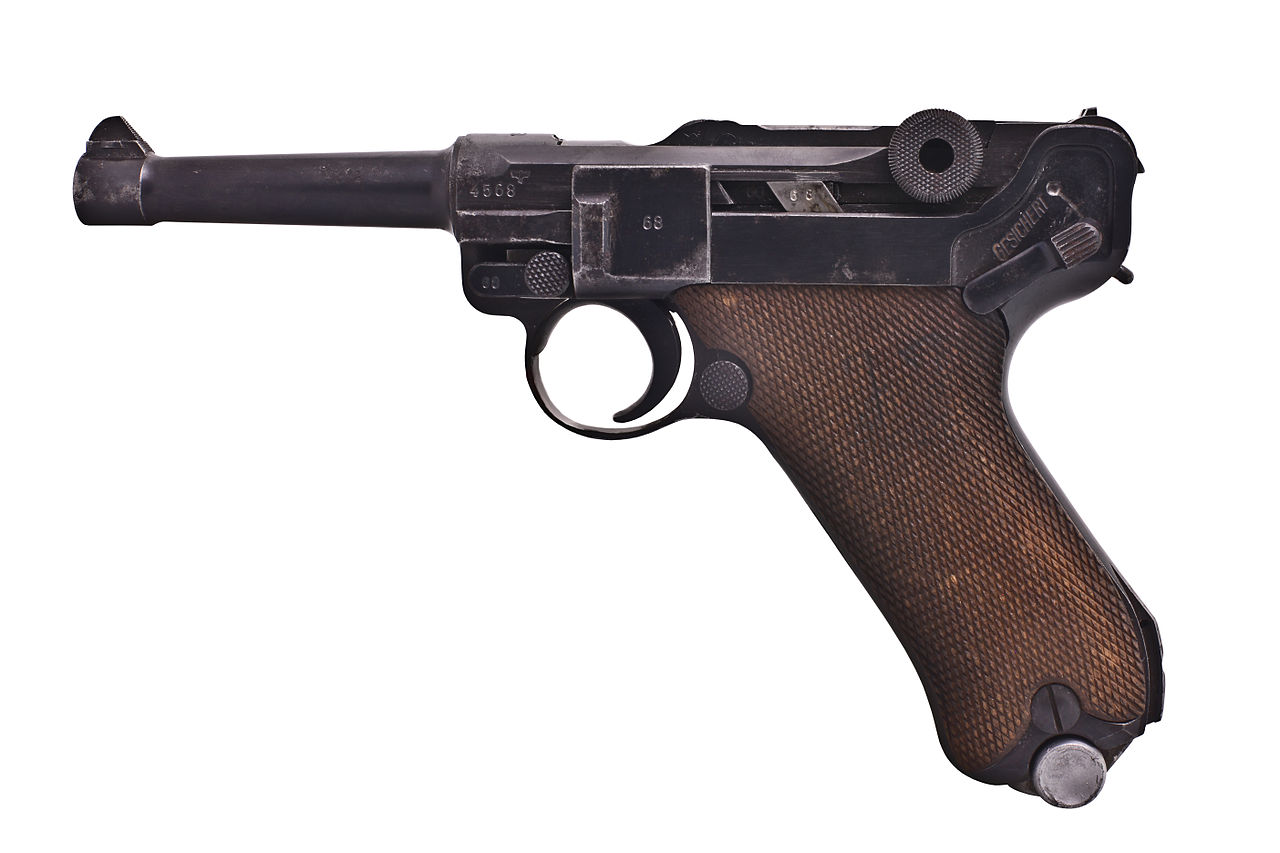
The P08 is formally known as the Pistole Parabellum and is a toggle locked recoil operated semi-automatic pistol. It was produced in several versions and by several nations from 1898 until 1948. The design was first pattened by Georg Luger. It was produced in Germany by German arms manufacturer Deutsche Waffen und Munitionsfabriken. It was first adopted by the Swiss Army in 1900. It was used by the German Military during World War One and World War Two. The Luger is an iconic pistol forever associated with Nazi Germany. It was eventually succeded by the Walther P38. The Luger has a toggle-lock action that uses a jointed arm to lock, as opposed to the slide actions of many other semi-automatic pistols. When a round is fired, the barrel and toggle assembly travel rearward due to recoil, both locked together at this point. The toggle strikes a cam built into the frame, which causes the knee joint to hinge and the toggle and breech assembly to unlock. The barrel strikes the frame which stops its rearward movement, but the toggle assembly continues moving, bending the knee joint. This extracts the spent casing from the chamber, and ejects it. The toggle and breech assembly then travel forward under spring tension and the next round is loaded from the magazine into the chamber. As is the case with several other semi-automatic pistol designs, the Luger mechanism does not perform well with under powered cartridges. Inadequate pressure can cause the mechanism to not cycle fully and jam. Luger pistols manufactured in Germany and Switzerland were well made and of high craftsmanship which resulted in a long service life. Some parts were hand fitted. The Luger pistol has been called a "natural pointer" for the barrel and front sight configuration and is one of the most accurate semi-automatic pistols ever made. Large numbers of Luger pistols were brought back from Germany by American soldiers and were highly prized souvenirs.
Walther PPK:
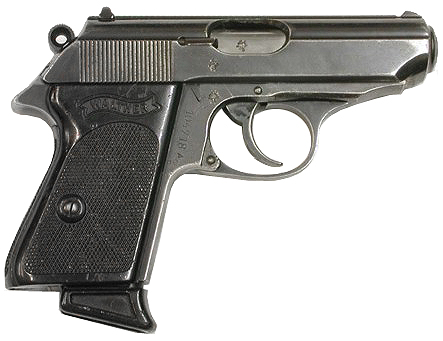
The Walther PPK Polizeipistole series pistols are blowback-operated semi-automatic pistols, developed by the German arms manufacturer Carl Walther GmbH Sportwaffen. The pistol employs an exposed hammer, a traditional double-action trigger mechanism, a single-column magazine, and a fixed barrel that acts as the guide rod for the recoil spring. Various PP series pistols are manufactured in Germany, France and the US. The PP series were among the most successful double action semi-automatic pistols ever produced. They are still produced and widely copied. The Soviet Makarov design was inspired by the Walther PPK. They are known for being very reliable and concealable. The PPK is a variant of the PP series of pistols. The PPK is a smaller version with a shorter barrel, grip and frame. This made the pistol popular for plain clothes and undercover work. "PPK" is an abbreviation for Polizeipistole Kriminal : police pistol - detective model. Adolf Hitler committed suicide with his PPK in the Fuheerbunker in Berlin and South Korean dictator Park Chung-Hee was assassinated by Kim Jae-gyu with a PPK pistol. The Walther PPK was also made famous as the weapon of choice for fictional character James Bond.
French Unique Model 17:
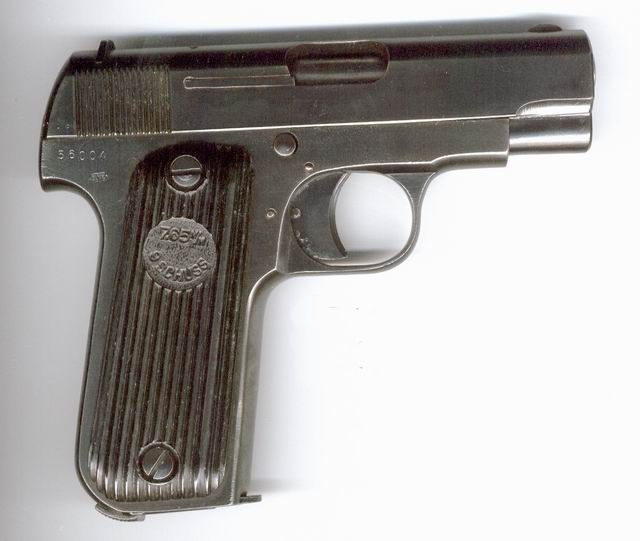
Also known as "Pistolet Automatique Unique Modele 17", the Unique Model 17 was a French made pistol. The manufacturing facilities were commandeered by the Germans during World War Two during the occupation of France. The guns were manufactured by Manufacture d'Armes de Pyrenees Francaises and fired the 7.65x17mm Browning .32 ACP cartridge. These pistols employed an 8-round detachable box magazine. The Model 17 was designed with a Single-Action trigger and utilized a blowback operation. These pistols did not employ a positive locking feature in the slide so there was not the usual visual "empty magazine" hold-open feature common to semi-automatic pistols. Pistols made after the Nazi Occupation, were known to the Germans as the "Kriegsmodell 17" variant. Production ended after the end of Nazi Occupation in 1944.
Spanish Star Model B:
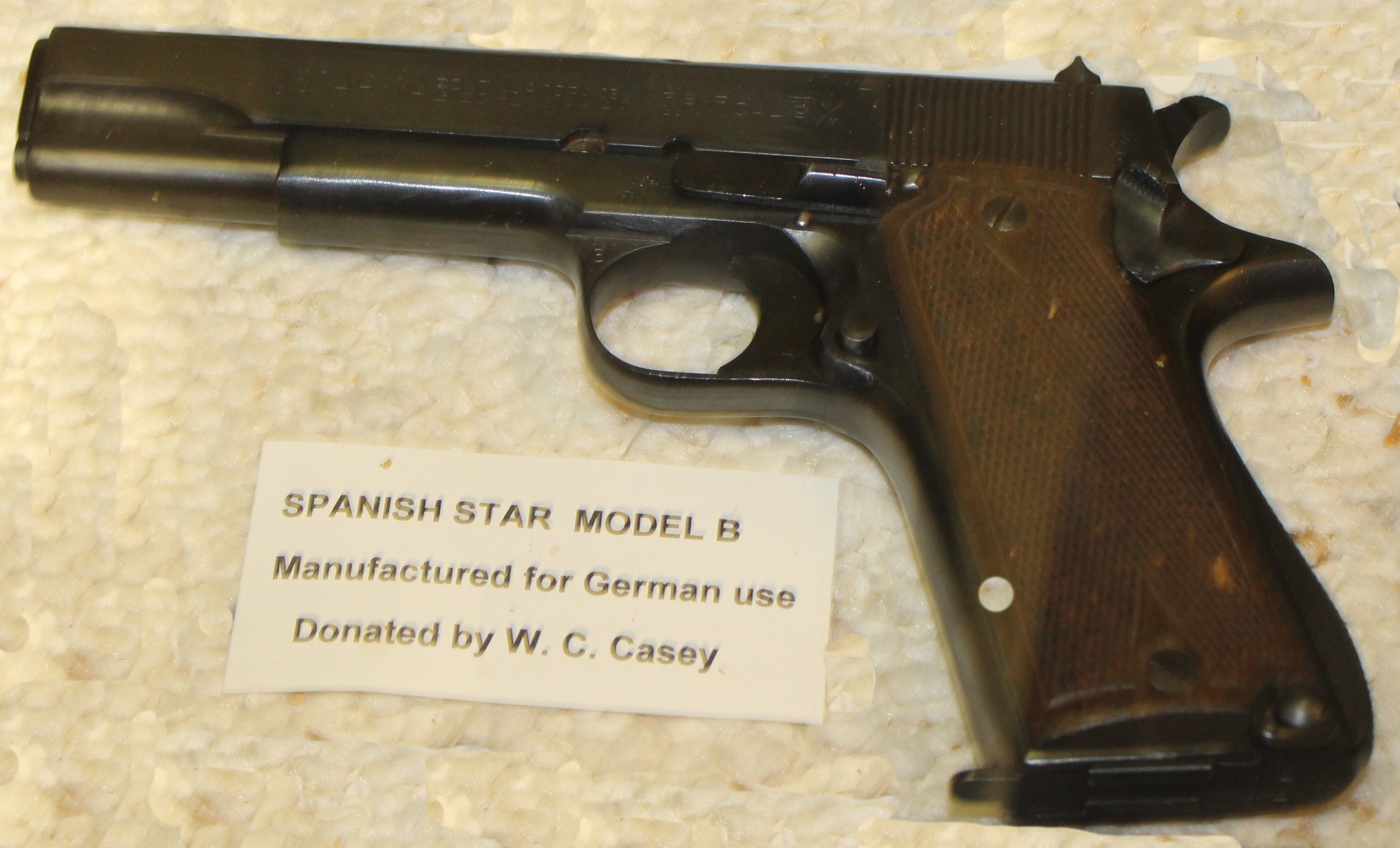
The Star Model B is a single-action semi-automatic pistol that fires the 9 mm Parabellum pistol cartridge. It was produced by Star Bonifacio Echeverria, S.A. in Spain. Production of the first model B began in 1924. Production of the second model B began in 1931 with several changes intended the make the pistol have the look and feel of the 1911 with key differences being the safety and trigger mechanism. Large numbers of these were produced. A series referred to as the B.08 were issued to police and some military units. These were considered cheap imports and not first line weapons and were instead issued to address shortages. These were produced between 1942 and 1944. Spain was officially neutral but Spanish manufactured Star pistols do carry Nazi proof marks. These were typically issued to civilian police and rear echelon units. Large numbers of these pistols were captured by the Soviets during World War Two.
Spanish Astra Model 300:
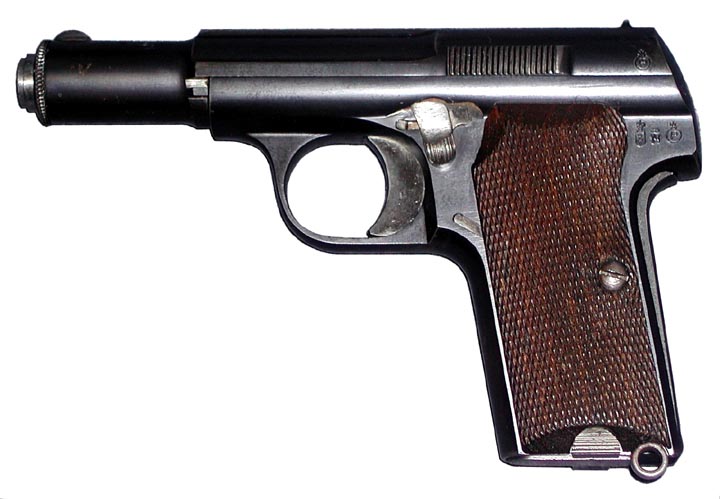
The Spanish Astra Model 300 is a single action semi-automatic pistol. These were chambered in .32 caliber and also 9mm kurz (.380). The pistol has a ramp front sight and notch rear sight machined into the slide. The sights are not adjustable. The pistol is fed by a single column seven round detachable magazine. The pistol has a hold open feature which retains the slide in an open position when the last round is fired. The model 300 is a scaled down version of the earlier model 400 and 600 and is almost identical. Production ended in 1946 with over 150,000 made. Nazi Germany acquired 85,000 Astra model 300 pistols. The pistol was very popular with multiple Spanish government agencies but was never adopted by the Spanish military.
P-38 Pistol:
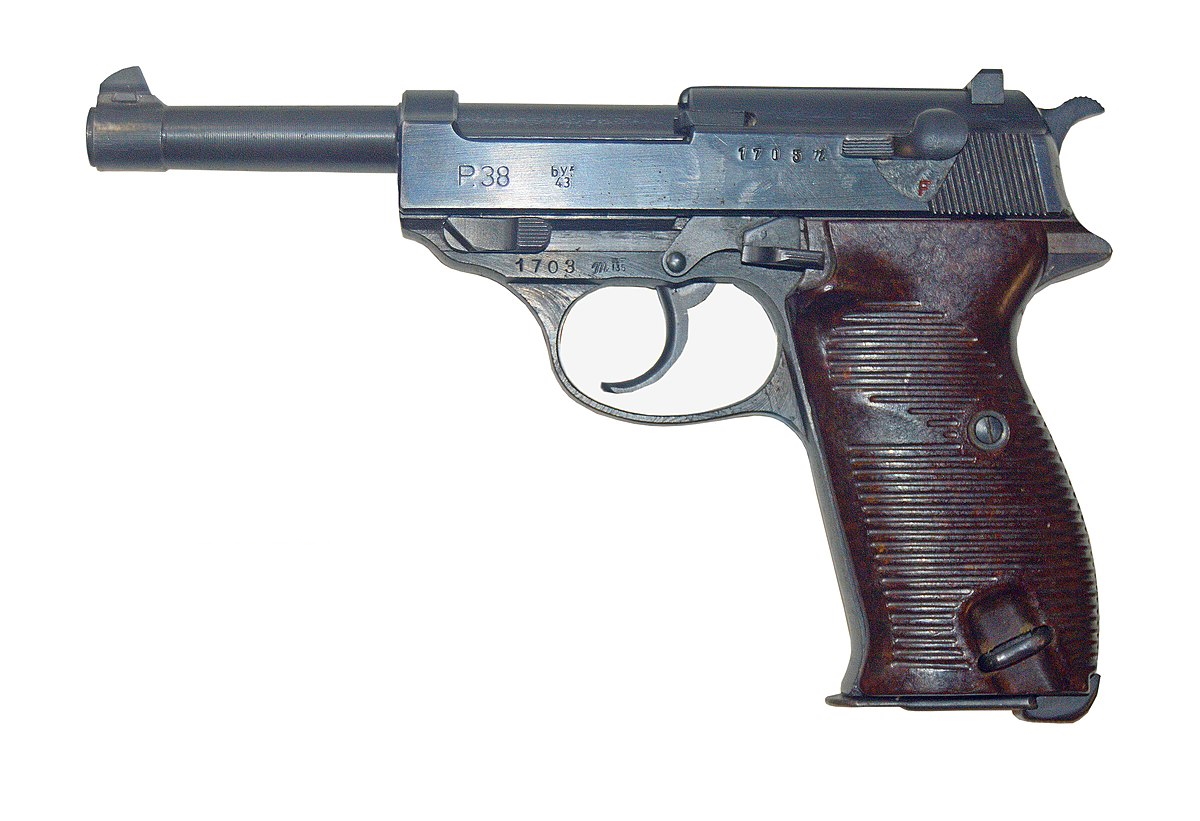
The Walther P38 (originally written Walther P.38) is a 9 mm semi-automatic pistol that was developed by Carl Walther GmbH. The pistol was designed as the service pistol for the Wehrmacht and was intended to replace the costly Luger. Mass production began in 1940. The P38 was the first locked-breech pistol to use a double-action/single-action (DA/SA) trigger. The shooter could chamber a round, use the safety-decocking lever to safely lower the hammer without firing the round, and carry the weapon loaded. Pulling the trigger cocks the hammer before firing the first shot with double-action operation. The firing mechanism extracts and ejects the first spent round, cocks the hammer, and chambers a fresh round for single-action operation with each subsequent shot. These are features found in many modern day handguns. First production P38 pistols were fitted with walnut grips. These were later replaced by Bakelite grips. Production ended in 1945. Manufacturing of the P38 for the German Military resumed in 1957. The P38 was the standard issue pistol for the West German military from 1957 to 1963. It was later redesignated the P1.
Browning M1922 .32 Caliber Pistol:
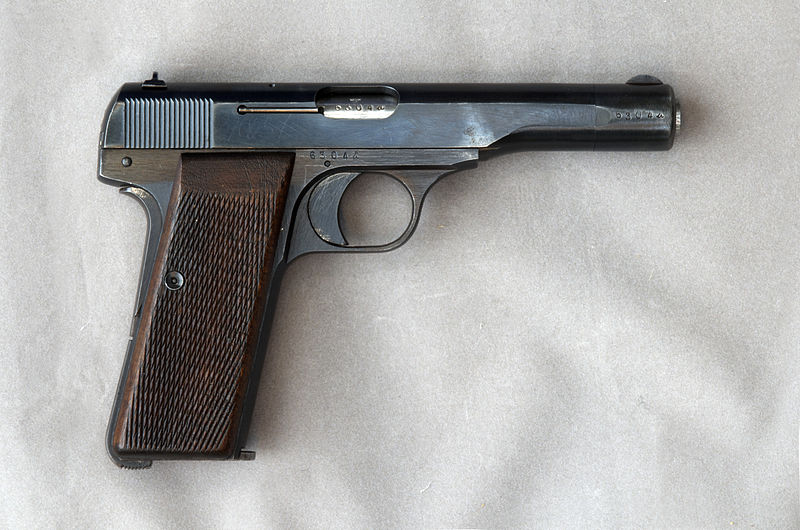
The Browning M1922 is a variant of the Model 1910. The M1922 is larger and has a longer barrel and a longer grip frame which accommodated two more rounds. This model was intended for military and police organizations. Model 1922 pistols saw extensive use in World War Two. Germany maintained production of the M1922 after the FN manufacturing facilities were acquired during the occupation of Belgium. Pistols manufactured after the occupation were stamped with Nazi production stamps. The FN Model 1922 was also used by the following countries: Yugoslavia , the Netherlands, Greece, Turkey, Romania, France, Finland, Denmark, and West Germany in the post war period.



